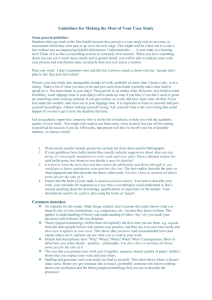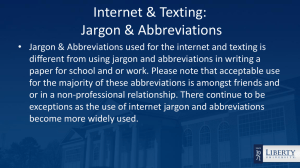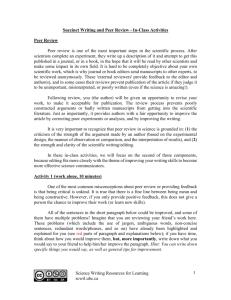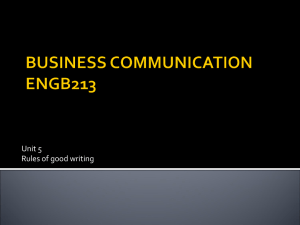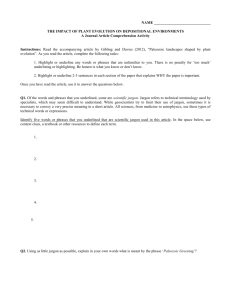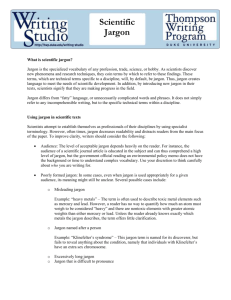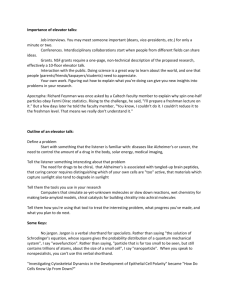Natasha Elander Linguistics Final
advertisement
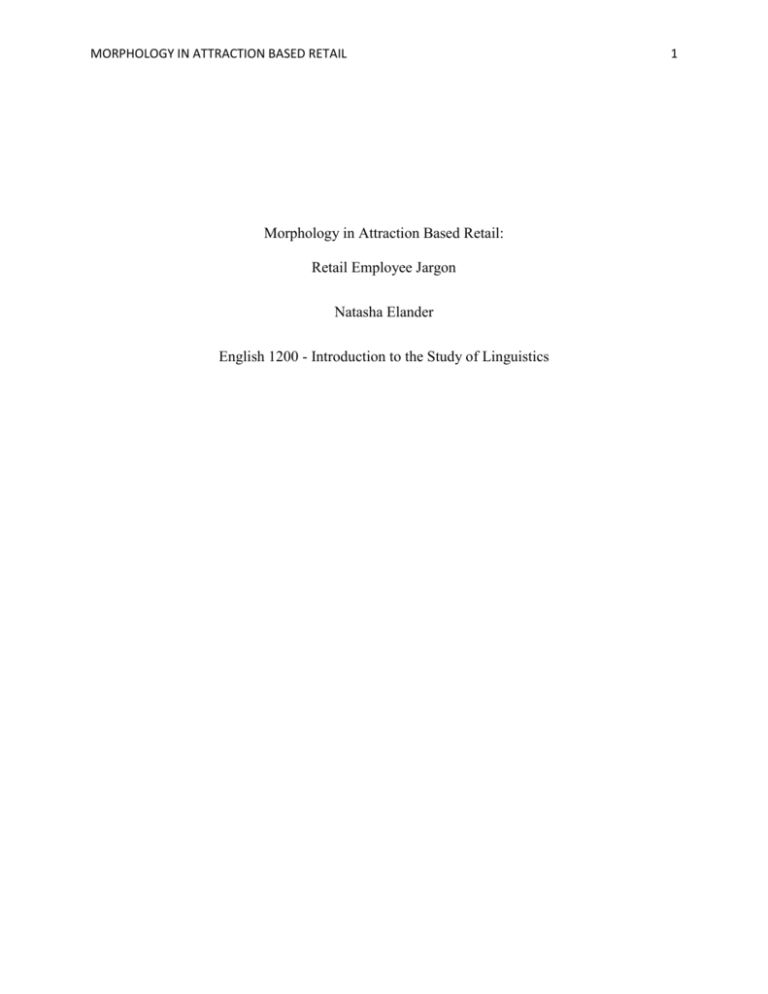
MORPHOLOGY IN ATTRACTION BASED RETAIL Morphology in Attraction Based Retail: Retail Employee Jargon Natasha Elander English 1200 - Introduction to the Study of Linguistics 1 MORPHOLOGY IN ATTRACTION BASED RETAIL 2 Hypothesis An individual’s lexicon increases and language is altered after prolonged periods of time in specific environments. Words and phrases are learned and added to their everyday language, becoming normalized to the speaker, even if it is a language/jargon not known outside of this respective environment. This jargon has the ability to become so ingrained in the speaker, that they use it to those outside of the jargon based group, sometimes causing confusion for both the speaker and listener. By dissecting jargon used with basic morphological methods and knowledge, not only can an understanding of the jargon can be reached, but an understanding of why the jargon is developed, and the words it is developed from. Abstract For this Linguistics Final project, the language used by a Utah’s Hogle Zoo (UHZ) retail employee was researched. I wanted to investigate the language learned through daily work onsite, and the morphology of this language. This research set out to prove that jargon used in a work environment becomes normal to the user, and roots itself easily into the speaker spending time in the environment. Laynee Waresnki, the individual whose language I have analyzed, has worked in the retail department at UHZ for about four years. She has picked up language; words, phrases, etc., that are unique to her work and location. Through recording her describing her work, the day-to-day aspects, events and stories, and asking her for details, I have found specific words and phrases that have been learned and rooted in Laynee’s lexicon directly from her work environment. MORPHOLOGY IN ATTRACTION BASED RETAIL 3 Introduction The hypothesis for this project stems from an everyday language reality: jargon. Jargon is defined in the class’s text Contemporary Linguistics: An Introduction as a language created by people associated with a particular work, hobby, etc. that contains its own specific vocabulary of terms (p. 516). Jargon is an intriguing language characteristic, created by a group of people all involved in the same environment or activity. The hypothesis wanted to test the extent of jargon, and the normalcy that jargon takes on to its speaker. Jargon is a component of Morphology, which is the area of linguistics focused on words and word formation (p. 116). Morphology analyzes words and word structure, from a words smallest components, morphemes, to words and longer phrases creates through attaching prefixes and affixes etc. Derivation, the affixational process of forming words with meanings or categories (verbs, nouns, etc.) that are different from its base word (p. 122), is an extremely important process of Morphology and Jargon. Derivation is an essential of jargon, since many jargon phrases are categorized by a derivational change to a word. There are many other morphological phenomena that effect the meaning of a word or create new words that also directly impact jargon. Compounding, combining to words to create a meaning (p. 127), Clipping, the shortening of polysyballic words (p. 139), and Backformation, creating new words by the removal of an affix from a word (p. 140), are just a few ways that jargon can be created from pre-existing language. This project dove deeper into her language used, picking out specific examples of jargon that morphed from a more understandable phrase to an outsider. The analysis of these examples MORPHOLOGY IN ATTRACTION BASED RETAIL 4 will help those outside of the UHZ retail environment understand the morphological development of the jargon used by its retail employees, and why the jargon itself was developed. Methodology To research this hypothesis, I engaged Laynee in a conversation about her work. While the recording aspect did have some implications on the recording (some of it being unnatural), much of the language seemed true to Laynee and her language. When jargon was used, I would ask her to expand on what she was saying, to describe what she meant. When pauses occurred, I prompted her with questions stemming from my basic knowledge of her job. Laynee agreed to be recorded, and signed a release form submitting to the recording. The recording was taken on my Samsung Galaxy 3 Smartphone via a recording application. It was then transferred to my laptop through a USB cable. Results Jargon has definitely been learned and implemented into Laynee’s language. Throughout the recording, Laynee used many utterances that were job specific, and would be confusing to an outsider. This language has become such a part of Laynee’s lexicon that the usage of it seemed completely ‘normal’ and simple to her, and she seemed to believe it was a language that could be understood by any listener. During the many moments in the recording when Laynee used words and phrases that could not be understood to those outside of her work environment, I asked her to elaborate or explain things further. When asked to expand on the meaning of the words or phrases used, she seemed slightly startled by the listener’s inability to understand the language she used, proving MORPHOLOGY IN ATTRACTION BASED RETAIL 5 that the jargon she uses daily in her work has become so ingrained in her lexicon, that to her it is “regular” or “normal” language. Below I have transcribed a handful of the words and phrases Laynee has used, and have broken them down, in trees, and described them, considering the usage in a sentence, and Laynee’s descriptions. By doing this, it is a bit easier to see the origin of the jargon, and possibly some of the reasoning as to why the specific words and phrases were created. - Cart N N N N N Af N N Cart Cart s Exit Cart ‘Cart’ is a word used often in Laynee’s recording. While the derivation (form) of the word remains the same throughout the jargon (noun), the meaning is what differs in UHZ jargon. Cart has become a synonym for “satellite store” or a location store. ‘Cart’ is also typically being compounded with a specific word, to denote the specific cart’s location or items that it sells, i.e.: ‘Monkey Cart,’ ‘Elephant Cart,’ and ‘Exit Cart’ (treed above). - Promo N Adj. N N Promotional Plush N Promo ‘Promo’ is a word used often to describe a sale item from the store that Laynee and the other retail employees sell. It stems from the original phrase ‘Promotional Plush’ which goes through a MORPHOLOGY IN ATTRACTION BASED RETAIL 6 backforming and clipping process, to become the shortened word ‘Promo.’ - Relief N N N N Relief Lunch V N V Relief Relieve V V Relieve Af -ing Relief gets a somewhat of an altered meaning in the UHZ jargon. Staff can be specifically scheduled as the ‘Lunch Relief,’ making them the individual who gives breaks to other employees. The word ‘Relief’ is compounded to become ‘Lunch Relief.’ The act of giving these breaks called ‘Relieving,’ turning the noun of ‘Relief’ into a verb. - Walk Floor V N V Walk N (the) V N Sales Floor V N Walk Floor The phrase ‘Walk Floor,’ or ‘Walking Floor,’ is a phrase created in Laynee’s work environment. This phrase takes a sentence and morphs it into one simple compounded word. It is done with a bit of backforming, and assumes that the person ‘walking floor’ understands that ‘floor’ fills the place of the deleted ‘sales.’ As Laynee describes it, this jargon phrase means to ‘walk the sales floor; cleaning and interacting with shoppers.’ The shortened direction is a faster version to fire off to an employee. MORPHOLOGY IN ATTRACTION BASED RETAIL - 7 Doom Time N N N N Doom Time N N Doom N Time While the created phrase ‘Doom Time’ is not derivational in anyway (As it remains a noun throughout its compounding) it is a specific phrase that holds a specific meaning to Laynee and the staff at UHZ. Saying just the utterance ‘Doom Time’ (a time of night when every register/computer crashes) would immediately register an understanding with the staff in retail. ‘Doom Time’ means one specific time and happening only, and all staff are aware of this phrases history. - Greeter V N V V Af Greet Greet -er Greeter is a word created to describe “the person who greets.” The word ‘greet’ goes through a derivational change as the affix –er turns the verb into a noun. In her work, Laynee has a specific staff person scheduled to greet shopper who come into the retail store. MORPHOLOGY IN ATTRACTION BASED RETAIL - 8 Foods N N N N Food Department N Food Af -s ‘Foods’ is the word used in replacement of the phrase ‘food department’ at UHZ. Phrases like “in foods” are used instead of “in the food department.” And while the clipping of the word department does not cause a derivational change, the shortening of the words makes the reference in regular conversation a little tricky to understand if you are not acquainted with the UHZ work environment. - Bags N N N N Till Bags N Bags At UHZ, ‘Bags’ is a backformed word for the phrase ‘till bags’ or ‘register bags.’ It is used in phrases like “Go count the bags,” or “Set up the bags.” Laynee’s usage of this word suggests that using ‘bags’ is enough for everyone to know that ‘till bags’ (or ‘bags full of money’) are being referenced. Most likely, this was backformed for efficiency or utterance and to ensure that staff could discuss their register bags while in store without necessarily letting shoppers know they were discussing money. MORPHOLOGY IN ATTRACTION BASED RETAIL - Plushies N N Plush 9 Adj N N N -Af Animal Plush -y N Plush Adj. -y Af -ies The phrase ‘plush animal’ goes through a few formations here. It is clipped to become just ‘plush,’ but they becomes ‘plushy,’ the description of something that is ‘like plush.’ This is a derivational change, which then is morphed again into ‘plushies,’ a word meaning ‘multiple plush animals.’ This is another derivational change, from adjective to noun. The shortening of a full description most likely makes it easier to quickly make staff aware of the item(s) being discussed. - Spoilage V V Spoil N V Spoil Af -age Spoilage is used once in the recording to describe spoiled (damaged or broken) store product. Spoilage goes through a derivational change, morphing from the verb ‘spoil’ to ‘spoilage,’ which is a noun (and most often considered in a “plural” form). This affixation is convenient, and easier to communicate with staff. It also prevents staff from using words like “broken product” etc., in front of shoppers who may be buying a similar product. MORPHOLOGY IN ATTRACTION BASED RETAIL 10 Overall, it appears that much of the jargon used in Laynee’s work environment was created for ease and efficiency. Shortening words and phrases makes it easier to direct staff in busy sales times, and using words that only the staff understands prevents problems with shoppers in store. The jargon itself is not difficult to understand when explained and broken down, treed out, and defined. Implications The findings in this research is relevant to Laynee’s life because her usage of this language does set her apart from those who are not able to understand it. This could become a problem if she has difficulty explaining her meaning, or if people refuse to listen. Finding so many examples of this jargon usage and possible word confusion also leads me to believe that it happens in almost any work place, activity setting, etc. As far as language judgments, I don’t necessarily have any. I am intrigued by the ability of people to change, alter, and create words, especially words for specific situations and environments. Moving forward I think I will just make sure to put in an effort to understand the language of someone I don’t understand, and not to hesitate to ask questions to further my understanding. MORPHOLOGY IN ATTRACTION BASED RETAIL 11 References O’Grady, W., Archibald, J., Aronoff, M., Rees-Miller, J. (2010). Contemporary Linguistics: An Introduction (6th edition). Boston/New York. Bedford/St. Martins. MORPHOLOGY IN ATTRACTION BASED RETAIL 12
